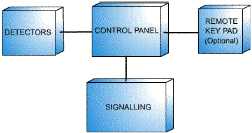Alarm System Basics Every alarm system has three main parts as shown (right). In normal systems these are interconnected
using multi-core cable.
Control Panels can range from very basic key operated models (which we do not supply) through to very sophisticated models
with digital communicators. Control Panels can be supplied with an integral keypad, as a blank endstation for use with one or more keypads, or as a combination of the two. Signalling units also range from simple external sounders (powered solely from the Control Panel) through self conttained units c/w sounder(s) and strobe(s)and an internal rechargeable battery
such that even if the cable to the sounder unit is cut the sounder and strobe will still operate (these are the type of unit we supply).
There are a wide range of detectors available. In ordinary domestic installatios the two types commonly used are magnetic contacts and Passive Infra-reds (PIRs).
These two types are what we would recommend for the DIY installer.

Control Panels
The Control Panel monitors the status of the detectors
and processes any alarm condition in order to activate the signalling. All modern Control Panels have the following basic features.
Mains powered with provision for rechargeable battery back-up.
Signalling
These are the devices that signal an alarm condition. The most common signalling device is the sounder (bell in days
gone by) and strobe. Other signalling devices are digital communicators - where the alarm information is sent to a monitoring station for verification prior to notifying
the relevant authorities - Speech Diallers - which can be programmed to dial up to 4 different numbers and deliver different pre-recorded messages. The main types of signalling used are:
Internal Sounder (or basic external sounder). These sounders are powered solely from the Control Panel. This means that if the cable to the sounder is cut then that
particular sounder will not operate. However if the sounder has had its tamper circuit connected then any other signalling devices will operate due to the tamper circuit being tripped.
Internal sounders are a very good deterrent in that if an intruder does enter the property then an internal high volume sounder is very disorientating.
Detectors
These are the devices that are used to detect an intrusion into the protected area. There are a lot of different types of detector, some of which are quite specialised,
but for domestic situations the following three types will cover most situations.
Magnetic Contacts. These detectors are present in nearly every installation. The detector is supplied in two parts - a reed switch and an operating magnet. In a typical application
(say fitted to a door or window) the reed switch (fitted to the door frame) is held closed by the adjacent magnet (fitted to the door). This is known as a Normally Closed (NC) circuit and is the normal
method of wiring detectors. There are two main types of magnetic contact - 'flush' and 'surface'. There is a third type - the user operated Personal Attack Button.
Advantages
Disadvantages
Advantages
Disadvantages
The working principle of the PIR detector is its ability to detect the radiated heat of an object. If the object is moving then the PIR detects the change in the radiated heat and signals an alarm.
PIR detectors typically have a 90 degree coverage over 10 to 15 metres. PIRs can also be fitted with curtain and pet lenses.
Advantages
Disadvantages
Dual Technology detectors typically have a 90 degree coverage over 10 to 15 metres.
Advantages
Disadvantages
Advantages
Disadvantages